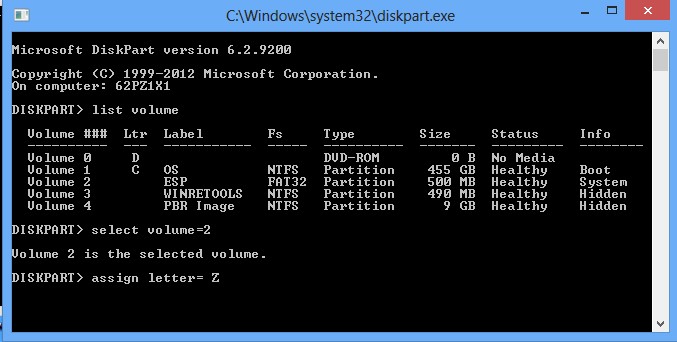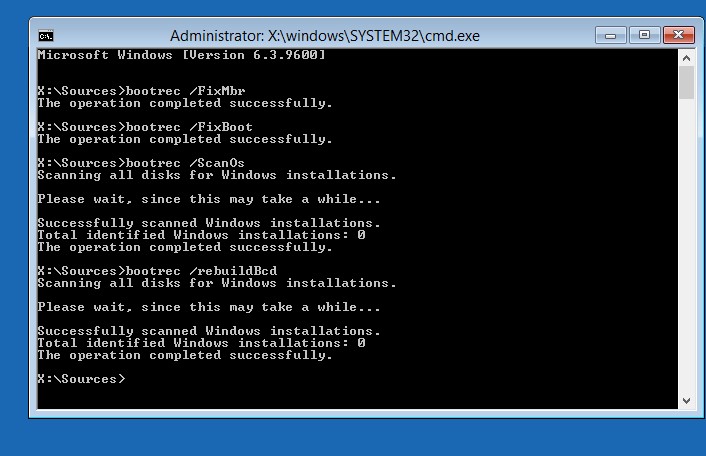При включении компьютера или ноутбука вы можете столкнуться с ошибкой «Вашему ПК не удалось правильно загрузиться» или «Ваш компьютер необходимо восстановить» с кодом 0xc0000001, иногда — с указанием на файл Windows\System32\winload.efi, чаще — без указания каких-либо проблемных файлов, также возможен текст «Требуемое устройство не подключено или недоступно» или текст на английском языке: «Your PC couldn’t start properly», даже в русскоязычной версии Windows 11/10.
В этой инструкции подробно о том, как исправить ошибку 0xc0000001 при загрузке Windows 10 или 11 в различных ситуациях, чем она может быть вызвана и дополнительная информация, которая может оказаться полезной для решения проблемы.
Причины и способы исправления ошибки 0xc0000001
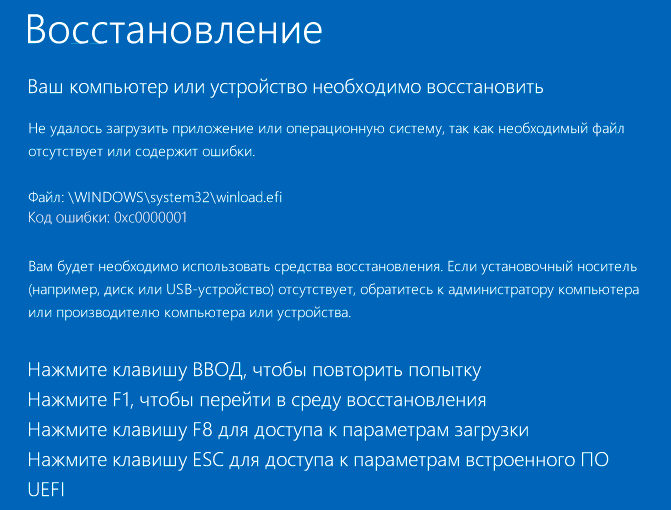
Среди основных причин ошибки 0xc0000001 — отсутствие необходимых для загрузки системных файлов (или невозможность доступа к ним, например, вследствие повреждения файловой системы на диске) и проблемы с оборудованием, либо его настройками.
Прежде чем приступать к предлагаемым далее методам решения проблемы, обратите внимание на следующие простые способы исправить ошибку, которые часто могут сработать:
- Если проблема появляется при первом включении компьютера или ноутбука после завершения работы, но исчезает при последующем, попробуйте отключить быстрый запуск Windows 10 (аналогично отключается и быстрый запуск Windows 11).
- Если на вашем компьютере несколько жестких дисков или SSD, а ошибка появилась после отключения одного из них, причиной ошибки может быть то, что на отключенном диске также находились необходимые системные файлы (даже если сама Windows 10 расположена на оставшемся диске). Здесь может пригодиться инструкция: Как перенести загрузчик Windows на другой диск.
- Если в БИОС в качестве первого устройства загрузки у вас выбран HDD или SSD, но также присутствует пункт Windows Boot Manager, попробуйте выбрать его вместо физического накопителя.
- В случае появления ошибки после обновления БИОС/UEFI или сброса его настроек, проверьте, не включён ли контроллер VMD в настройках (обычно в разделах System Agent Configuration — VMD Setup Menu, Storage Configuration — VMD Configuration или аналогичных), попробуйте его отключить (установить в Disabled), сохранить настройки и перезагрузить компьютер.
Если предыдущие пункты не подходят к вашей ситуации, приступаем к исправлению ошибки «Вашему ПК не удалось правильно загрузиться» или «Ваш компьютер необходимо восстановить» с кодом 0xc0000001.
Вход в среду восстановления Windows 11/10
Почти для любого из далее описанных методов нам потребуется войти в среду восстановления Windows. Как правило, при ошибке 0xc0000001 не удается использовать нажатие клавиши F8 для открытия параметров загрузки или (если предлагается) F1 для прямого входа в среду восстановления. Поэтому придётся использовать следующий метод:
- Создайте где-то на другом компьютере или ноутбуке загрузочную флешку или диск с Windows 10 (как создать: Загрузочная флешка Windows 10, Загрузочная флешка Windows 11) и загрузитесь с неё.
- Вам будет предложено нажать любую клавишу для загрузки с флешки, а после этого запустится программа установки Windows.
- Наша задача — нажать «Далее» на экране выбора языка, а на следующем экране нажать по пункту «Восстановление системы» внизу слева.
В результате будет загружена среда восстановления, здесь мы можем попробовать:
- Автоматическое восстановление при загрузке.
- Проверку файловой системы HDD или SSD на ошибки.
- Восстановление системных файлов Windows.
- Использовать точки восстановления.
- Попробовать перезаписать загрузчик.
А если ни один из указанных пунктов не сработает, попробовать проверить, помогут ли решить проблему действия с оборудованием компьютера или ноутбука.
Автоматическое восстановление при загрузке
Этот способ редко оказывается работоспособным при рассматриваемой ситуации, но его следует попробовать в первую очередь, так как это не займет много времени, не требует особенных навыков и иногда всё-таки срабатывает:
- В среде восстановления перейдите в «Поиск и устранение неисправностей».
- Нажмите «Восстановление при загрузке» и выберите ОС Windows 10 или Windows 11.
- Дождитесь завершения автоматической диагностики и исправления ошибок.
- Даже если вы увидите сообщение о том, что «Восстановление при загрузке не удалось восстановить компьютер», все равно попробуйте перезагрузить компьютер уже не с флешки, а выбрав Windows Boot Manager (при наличии) или системный диск в качестве первого устройства загрузки в БИОС/UEFI.
Проверка файловой системы системного диска HDD или SSD на ошибки
Иногда причиной ошибки 0xc0000001 являются ошибки файловой системы на диске и я не рекомендую пропускать этот шаг, хотя бы потому, что при таких ошибках следующий способ исправления ошибки также может оказаться безрезультатным:
- В среде восстановления в разделе «Поиск и устранение неисправностей» выберите «Командная строка» для запуска командной строки. Или просто нажмите клавиши Shift+F10 (иногда на ноутбуках — Shift+Fn+F10) прямо в программе установки Windows 11/10, чтобы запустить командную строку.
- Введите по порядку команды (переключение языка ввода будет выполняться сочетанием клавиш Alt+Shift):
diskpart list volume exit
- В результате выполнения второй команды вы увидите список разделов диска, проверьте букву диска, на котором расположена Windows 11 или 10 — иногда в среде восстановления она отличается от стандартной C:, в этом случае в следующей команде используйте актуальную букву раздела диска.
- Введите команду
chkdsk C: /f
для запуска проверки файловой системы системного раздела диска на ошибки.
После проверки, если chkdsk сообщит об исправлении ошибок, попробуйте перезагрузить компьютер в обычном режиме.
Восстановление системных файлов Windows 10
Если причиной ошибки оказалось повреждение системных файлов Windows, например, удаление Windows\System32\winload.efi, с помощью тех же шагов, что были описаны выше, перейдите в командную строку, после чего используйте команду (с правильной буквой системного диска):
sfc /SCANNOW /OFFBOOTDIR=C:\ /OFFWINDIR=C:\Windows
Внимательно вводите все пробелы (например, перед offwindir) и учитывайте, что после начала сканирования системы у вас может появиться ощущение что процесс завис. Это не так — наберитесь терпения и дождитесь завершения операции.
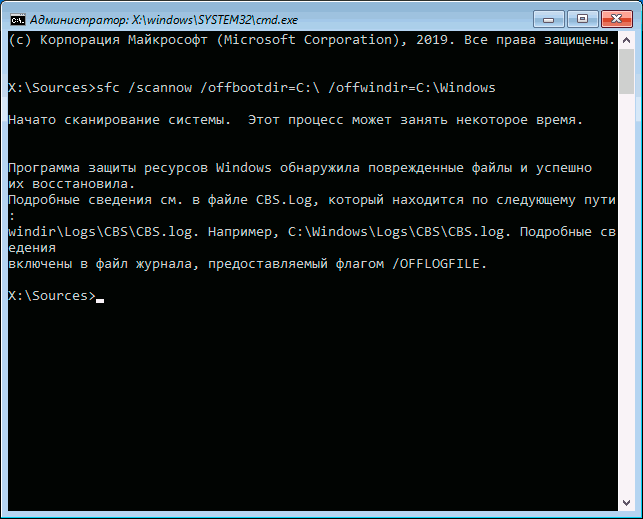
Если в результате вы увидите сообщение о том, что программа защиты ресурсов Windows обнаружила поврежденные файлы и успешно их восстановила — пробуем загрузить компьютер или ноутбук в обычном режиме, уже не с флешки — возможно, запуск пройдёт успешно.
В случае, когда предыдущие подходы не помогают, попробуйте:
- Использовать точки восстановления системы при их наличии. В среде восстановления — Поиск и устранение неисправностей — Восстановление системы. Есть и другие методы воспользоваться точками восстановления.
- Вручную восстановить загрузчик Windows 10 или Windows 11.
Возможные аппаратные причины ошибки 0xc0000001 при загрузке компьютера или ноутбука
Среди возможных причин проблем с загрузкой с кодом ошибки 0xc0000001 могут быть и аппаратные проблемы. Среди распространенных вариантов:
- Проблемы с оперативной памятью. Можно попробовать отключить любой разгон памяти (если включался), а также оставить только один модуль RAM и проверить, исчезнет ли ошибка. Если нет — попробовать поставить вместо него другой и повторить проверку.
- Проблемы со шлейфами подключения дисков: можно попробовать поменять кабели SATA, убедиться что они плотно подключены как со стороны накопителя, так и со стороны материнской платы.
- Проблемы с питанием, а точнее его недостатком. Учитывайте, что выходящий из строя блок питания может продолжать работать, но быть не в состоянии обеспечить необходимую мощность. При наличии возможности можно попробовать отключить необязательные потребители (например, дискретную видеокарту, оставив только интегрированное видео).
- По некоторым отзывам иногда причиной оказываются Ethernet и Wi-Fi адаптеры и срабатывает их физическое отключение или отключение в БИОС (при наличии там соответствующих опций).
Если один из способов помог вам исправить ошибку 0xc0000001, поделитесь в комментариях, какой именно: такая статистика может быть полезной для других пользователей.
The Winload.EFI error (0xc0000001) causes your computer to halt during startup, displaying a blue screen with a message that your PC needs to be repaired. This error generally means that the Windows Boot Manager (BOOTMGR) is unable to locate the necessary boot files, particularly the Winload.EFI file, which is essential for starting the operating system.
The most common cause of this issue is a corrupted or missing boot file, often due to improper shutdowns, disk errors, or changes in the system’s boot configuration. Additionally, issues with UEFI firmware or damaged system files can also trigger this error.

On a Windows 8/8.1/10 system, the error usually appears in the following forms:
Your PC needs to be repaired. The application or operating system couldn’t be loaded because a required file is missing or contains errors. File: \windows\system32\winload.efi Error code: 0xc000***
or:
Your PC needs to be repaired. An unexpected error has occurred. Error code: 0xc0000001. You’ll need to use the recovery tools on your installation media. If you don’t have any installation media, contact your system administrator or PC manufacturer.
How to Boot into BIOS to Change Boot Order
You must know how to boot and change the boot order since this will be needed to perform the solutions below. Restart your computer. Enter your computer’s BIOS (or UEFI) settings as soon as it starts up. The key that you need to press to enter these settings depends on the manufacturer of your computer’s motherboard and can be anything from Esc, Delete, or F2 to F8, F10, or F12, with F2 being the most common. This information is displayed on the POST screen and in the manual supplied with your system. A quick Google search asking “how to enter BIOS” followed by your model number will also list the results.
Method 1: Disable Secure Boot
If you have a UEFI-based computer instead of the old traditional BIOS, the issue can be caused by a certain setting in UEFI called Secure Boot. It can stop your system from accessing the winload.efi file, causing this error to appear. Windows 8 and later versions have this feature enabled by default.
To disable Secure Boot, boot to BIOS or UEFI. The UEFI setup user interface differs by model. Generally, look for Secure Boot, which can be found in its own separate section, or under the Security tab, the Boot tab, or the Authentication tab, depending on your system model. Consult your system model’s manual to know exactly where it is. Once you find the Secure Boot option in a tab, disable it or turn it off.

Save the UEFI settings and exit. Now boot up your system normally. If you still get the same error, move on to the next solution.
Method 2: Repair Boot Record
Restoring the Boot Record fixes the Winload.EFI error by correcting corrupted or missing boot configurations, enabling the system to locate necessary boot files. This process rewrites the Master Boot Record (MBR), Boot Configuration Data (BCD), and related structures that control startup, re-establishing the pathways the Windows Boot Manager uses to load the operating system, effectively resolving the 0xc0000001 error.
Windows 7 Users
In order to continue, you will need to start Windows in repair mode. For that, (see steps here).
Once you boot to start-up repair and see the “System Recovery Options,” choose Command Prompt. Once the command prompt’s black window appears, type the following commands and press Enter after each line.
bootrec /fixboot bootrec /scanos bootrec /fixmbr bootrec /rebuildbcd
After the commands have executed successfully, restart your system and check if the issue is still there.
If the issue is still there, then repeat the above procedure and execute the commands 3 times each. Now check if the issue is resolved. If not, move on to the next solution.
Windows 8/8.1/10
To start Windows 8/8.1 and 10 in Repair Mode, see steps here.
In the advanced options, click Command Prompt.
Once the command prompt’s black window appears, type the following commands and press Enter after each line.
bootrec /fixboot bootrec /scanos bootrec /fixmbr bootrec /rebuildbcd
After the commands have executed successfully, restart your system and check if the issue is still there.
If the issue persists, then repeat the above procedure and execute the commands 3 times each. Now check if the issue is resolved. If not, move on to the next solution.
Method 3: Perform a Startup Repair
You may get the error code 0XC0000001 if the startup items of your system are corrupt. In this context, performing a startup repair of the system may solve the problem. But before that, make sure the system’s boot order in the BIOS settings is properly configured (the Windows drive is first in the boot order).
- Power off your system (if it is powered on) and then power it back on.
- When the Windows logo appears (with spinning dots), press and hold the power button to forcibly shut down the system.
- Repeat the process thrice and at the third time, your system may boot into the Recovery Environment. If so, select Troubleshoot.
- Now open Advanced Options and select Startup Repair
- Once Startup Repair has completed its course, check if the system is clear of the error code 0XC0000001.
- If the issue persists, create a Windows 10 bootable USB and boot system through that USB device (if you cannot boot by using the USB, then try different USB ports on the system and also make sure Secure Boot is disabled in the system’s BIOS).
- Now select Repair Your Computer and open Troubleshoot.
- Then select Advanced Options and open Startup Repair.
- Now follow the prompts on the screen, and once the Startup Repair has completed its course, reboot your PC to check if the 0XC0000001 issue is resolved.
Method 4: Uninstall the Buggy Update
Microsoft has a very long history of releasing buggy updates, and the issue at hand can also be a result of the same. In this case, removing the buggy update (either Quality or Feature Update) may solve the problem.
- Boot your system into the Recovery Environment as discussed in solution 1 and open Troubleshoot.
- Now select Advanced Options and open Uninstall Updates.
- Then either select Uninstall Latest Quality Update or Uninstall Latest Feature Update.
- Now let the uninstallation complete, and then reboot your PC to check if the system is clear of the BSOD error.
Method 5: Perform a CHKDSK Scan
Running a CHKDSK scan can pinpoint and repair disk errors that might be causing the Winload.EFI error. Over time, bad sectors, file system corruption, or other disk-related issues can damage essential boot files, leading to the 0xc0000001 error.
CHKDSK (Check Disk) examines the integrity of your hard drive, detects these issues, and attempts to fix them.
- Boot your system in the Recovery Environment or (preferably) use Repair Your Computer by booting your system through a Windows 10 bootable USB (as discussed in solution 1) and open Troubleshoot.
- Now select Advanced Options and open Command Prompt.
- Then execute the following to find the drive letter of the system drive (the drive letter may not be the same as shown in Windows):
Diskpart
- Now list down the partitions by executing the following:
list vol
- Now check for the drive letter (e.g., E drive) of the OS drive (most probably, having Boot in the Info column, or otherwise use Dir in the Command Prompt to check the contents of the partition) and then close the Diskpart by executing the following:
Exit
- Then navigate to the system’s drive (in the Command Prompt) by entering the drive letter followed by a colon (e.g., if the system drive is C, then enter C: and hit Enter).
- Now run the Chkdsk scan by executing the following (where C is the system drive):
chkdsk C: /r
- Then wait till the Chkdsk scan is completed and, once done, boot into Windows and check if the BSOD error code 0XC0000001 is resolved.
If the above process is too technical for you, then attach the problematic system’s hard drive to another PC and perform the Chkdsk scan there to check if the BSOD issue is resolved.
Method 6: Use the BCDBoot Utility
Using the BCDBoot utility re-establishes the link between system files and the Windows Boot Manager, resolving the Winload.EFI error. It copies essential boot files to the system partition and creates a new Boot Configuration Data (BCD) store, ensuring the Windows Boot Manager can load these files correctly.
This is particularly useful when the existing BCD is corrupted or missing, allowing you to rebuild the boot environment and fix the 0xc0000001 error.
- Type diskpart and press Enter.
- Type list volume and press Enter.
- Under the label row, find the label System Reserved and note its corresponding Volume number.
- Now type select Volume=N and press Enter, where N is the Volume number you noted earlier.
- Now type assign letter=w and press Enter.
- Type exit and press Enter.
- Type bcdboot c:\Windows /s w: /f uefi and press Enter.
Now restart your system and check if the issue is resolved. If not, proceed to Method 4.
Method 7: Disable Anti-Malware Protection
- Power on your system, then forcefully shut it down when you see the Windows logo. Repeat the process a few times until you get the Recovery screen.
- Click See advanced repair options.
- Then click on Troubleshoot > Advanced Options.
- Click Startup settings in Advanced Options.
- In the startup settings screen, click on Restart.
- The Startup Settings menu will appear after the restart.
- Now press 8 on your keyboard. Your Windows will launch with anti-malware disabled only for this session.
Solution 8: Perform a System Restore
The error code 0XC0000001 could be a result of a recent (unwanted) change to the system, and restoring the system to an earlier point in time when it was operating fine may solve the problem.
- Boot your system into the Recovery Environment (as discussed in solution 1) and open Troubleshoot.
- Now open Advanced Options and select System Restore.
- Then follow the prompts to restore the system to an earlier point in time. When the process is complete, reboot your PC to check if the system is clear of the 0XC0000001 error.
You can also use the following in the Command Prompt to perform the System Restore (where C is the system drive, which you can find by following the steps mentioned in the Chkdsk solution):
rstrui.exe /OFFLINE:C:\Windows
Method 9: Rename the Corrupt Registry Files and Copy the Backup Registry Files
You may encounter the 0XC0000001 error if some of the essential files (especially those related to the system’s registry) are corrupt. In this scenario, renaming the corrupt files and placing the original OS files (from the registry backup folder) may solve the problem.
- Launch the Command Prompt in the Recovery Environment (as discussed in solution 3) and execute the following (where C is the system drive) one by one (make sure to press the Enter key afterward):
Ren C:\windows\system32\config\SAM SAM.BAK Ren C:\windows\system32\config\SYSTEM SYSTEM.BAK Ren C:\windows\system32\config\SECURITY SECURITY.BAK Ren C:\windows\system32\config\DEFAULT DEFAULT.BAK Ren C:\windows\system32\config\SOFTWARE SOFTWARE.BAK Copy C:\Windows\System32\config\RegBack\SAM C:\windows\system32\config Copy C:\Windows\System32\config\RegBack\SYSTEM C:\windows\system32\config Copy C:\Windows\System32\config\RegBack\SECURITY C:\windows\system32\config Copy C:\Windows\System32\config\RegBack\DEFAULT C:\windows\system32\config Copy C:\Windows\System32\config\RegBack\SOFTWARE C:\windows\system32\config
- Once the above commands are executed, reboot your PC into Windows and check if the BSOD issue is resolved.
Method 10: Perform System Operations in Command Prompt
There are different cmdlets (like Bootrec, SFC, DISM, etc.) in the Command Prompt that can be used to solve the current BSOD issue.
Perform the SFC and DISM Scans
- Execute the following in the Recovery Environment’s Command Prompt (where D is the system drive):
sfc /scannow /offbootdir=d:\ /offwindir=d:\windows
- Once the scan is complete, type Exit in the Command Prompt and boot your system into Windows to check if the system is clear of the BSOD issue.
- If the issue persists, then check if performing a DISM scan to repair Windows (preferably, after attaching your system’s hard disk to another PC) solves the problem.
Disable Hibernation
If the issue started to occur after hibernating the system, then disabling hibernation may solve the problem.
- Launch the Command Prompt in the Recovery Environment and navigate to the system partition (as discussed in solution 3).
- Now execute the following cmdlet to disable hibernation:
powercfg -h off
Disable Hibernation in the Command Prompt - Then reboot your PC and check if the system is clear of the BSOD issue.
Rename the EFI Folder
- Launch the Command Prompt in the Recovery Environment and navigate to the system drive.
- Now execute the following:
dir
- Then check if the EFI directory is shown. If so, then rename it by executing the following:
ren EFI oldEFI
Rename the EFI Folder in the System Drive - Now reboot your PC and check if the system is clear of the 0XC0000001 issue.
- If the issue persists, then check if deleting the EFI folder by executing the following in the Command Prompt in the Recovery Environment (make sure you are executing the command in the system drive):
rd /s C:\oldEFI
If the issue persists, then you may have to perform a clean installation of Windows either on a different partition/disk or after completely repartitioning the problematic drive. If you cannot back up the system drive data in any other way, then it will be better to use the Custom Install option (the system drive data will be in the Windows.old folder) when performing the clean installation of Windows.
,
If your Windows 10/11 PC does not start and goes to the recovery screen with error code 0xc0000001 «Your PC Couldn’t start properly», continue reading below to fix the problem.
The BSOD error 0xc0000001, usually appears after a Windows Update or a BIOS update. In other cases the problem appears after an improper computer shutdown or because of a damaged disk.
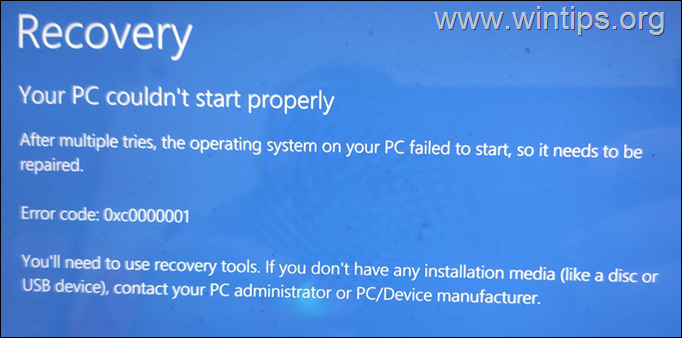
In this tutorial you ‘ll find instructions to resolve the Error 0xc0000001: Your PC Couldn’t start properly, in Windows 11, 10 or 8 OS.
How to FIX: Your PC Couldn’t start properly with Error code 0xc0000001, on Windows 10/8/7 OS.
Suggestion (Important): Before you continue to the methods below…
- Enter BIOS SETUP.
- Locate the SATA Configuration setting. (Commonly named as «SATA Mode» or «SATA Controller Mode» or «SATA Operation» or «Configure SATA as«).
- If the SATA Mode is set to RAID then change it to AHCI. If the SATA Mode is set to AHCI then change it to IDE.
- Save Changes and Exit BIOS Settings.
- Try to boot in Windows. If Windows doesn’t start, then revert the SATA setting back to what it was and proceed to apply the methods below.
Notes:
1. If you receive the 0xc0000001, on a system that you have used software mirroring for fault tolerance, then break the mirror first, with the DISKPART tool in Recovery Environment. Detailed instructions to do that can be found in Method-2 in this tutorial.
2. Requirement: In order to resolve the 0xc0000001 Boot error, you need to start your computer from a Windows USB installation/recovery media. If you don’t own a Windows Installation Media, then you can create one (corresponding to your Windows Edition and Version) directly from Microsoft.
- How to create a Windows 10 USB boot media.
- How to create a Windows 11 USB boot media.
Method 1. Fix Error 0xc0000001 with Startup Repair
1. Power on your PC and boot from a Windows 10 installation/recovery media.
2. At the Windows Setup screen choose Repair > Troubleshoot > Advanced Options > Startup Repair.

3. Click on Windows 10 and when the repair is completed, remove try to boot to Windows normally.

Method 2. Fix Boot Configuration Data using BOOTREC tool.*
* Note: This method usually works on Windows 7 & 8 systems.
1. Power on your PC and boot from a Windows 10 installation/recovery media.
2. At the Windows Setup screen press SHIFT + F10 to access command prompt, or choose Next –> Repair your computer –> Troubleshoot –> Advanced Options –> Command Prompt.
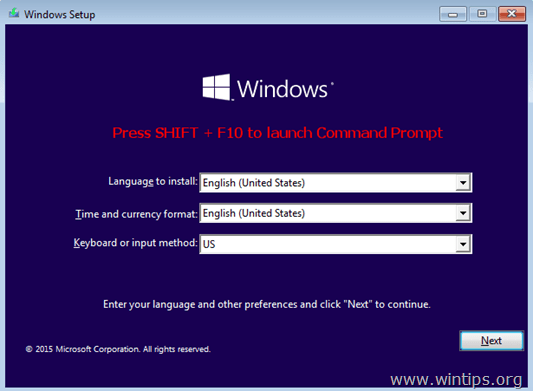
3. In command prompt type the following commands in order:
- bootrec /fixmbr
- bootrec /fixboot
* Note: If after executing the above command you receive that «Access is denied» give this command «bootsect /nt60 sys» and continue below.
- bootrec /scanos *
* Note: If after executing the «bootrec /scanos» command you receive that «Total identified Windows installations = 0» then give the following commands, before you continue to next step:
-
- bcdedit /export C:\bcdbackup
- C:
- cd boot
- attrib bcd -s -h –r
- ren C:\boot\bcd bcd.old
4. Rebuild Boot Configuration Data:
- bootrec /rebuildbcd
5. Press «A» to Add installation to boot list and press Enter.
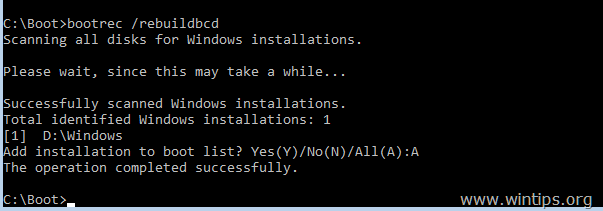
6. Close all windows and restart your computer. If Windows still fails to boot, then try Method 2.
Method 3. Repair Boot Configuration Data using BCDBOOT tool.
* Note: This method usually works on Windows 10/11 systems.
1. Power on your PC and boot from a Windows 10 installation/recovery media.
2. At the Windows Setup screen press SHIFT + F10 to access command prompt, or choose Next –> Repair your computer –> Troubleshoot –> Advanced Options –> Command Prompt.

3. In command prompt type the following commands in order:
- diskpart
- select disk 0
- list partition
4. Note the size in Megabytes of System Partition. *
* e.g. As you can see at the screenshot below, the partition size of System partition is 99 MB.
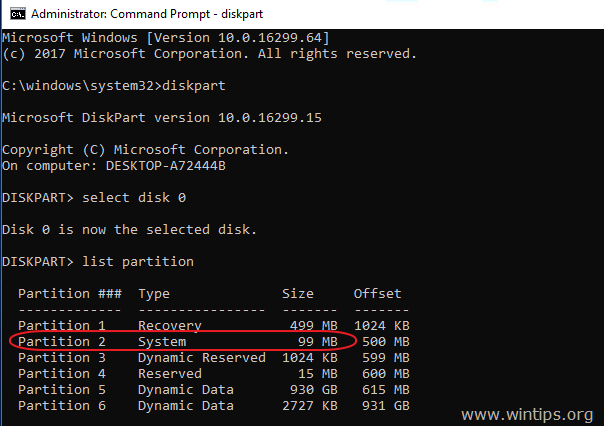
5. Find out the volume number of the system partition * and the drive letter of OS drive,** by typing this command:
- list volume
* At the previous step we found that the system partition is 99 MB. So, from the screenshot below, we understand that the System partition is the «Volume 2«.
** The OS Drive, is the drive where the Windows installed. Commonly this is the «Volume 0», the largest volume on the list. At this example the OS drive is located at «C» drive letter.

6. Select the System partition and assign a drive letter to it. Then exit DISKPART:
- select volume 2 *
- assign letter=Z
- exit
* Note: Change the Volume number according your case.
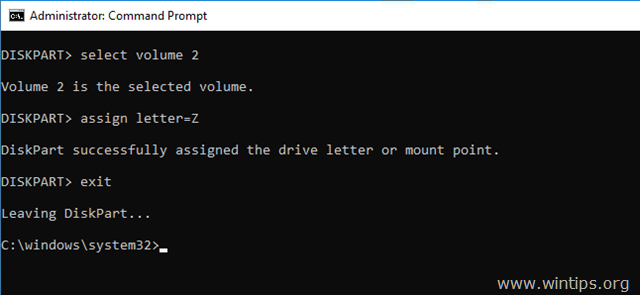
7. Finally, in command prompt give this command:
- bcdboot C:\windows /s Z: /f ALL
* Note: Replace the letter «C«, according the drive letter of the OS volume at your case.

8. Close all windows, remove the Windows Recovery media and try to boot in Windows normally. If Windows doesn’t boot, then follow the same steps, but at the end, type this command:
- bcdboot C:\windows /s Z: /f UEFI

Additional help: If you cannot fix the problem using the above methods, read this article: How to Repair Windows 10/11 without losing files.
That’s it! Which method worked for you?
Let me know if this guide has helped you by leaving your comment about your experience. Please like and share this guide to help others.
If this article was useful for you, please consider supporting us by making a donation. Even $1 can a make a huge difference for us in our effort to continue to help others while keeping this site free:
- Author
- Recent Posts
Konstantinos is the founder and administrator of Wintips.org. Since 1995 he works and provides IT support as a computer and network expert to individuals and large companies. He is specialized in solving problems related to Windows or other Microsoft products (Windows Server, Office, Microsoft 365, etc.).
Рассмотрим еще одну распространенную ошибку загрузки Windows 10, вызванную повреждением или отсутствием файла winload.efi. Проблема проявляется следующим образом: Windows 10 перестает загружаться с ошибкой BSOD и следующим сообщением на экране загрузки:
Recovery
Your PC needs to be repaired
The application or operating system couldn’t be loaded because a required file is missing or contains errors.
File: \Windows\system32\winload.efi
Error code: 0xc000000f
You’ll need to use the recovery tools on your installation media. If you don’t have any installation media (like a disc or USB device), contact your system administrator or PC manufacturer.
Press Enter to try again
Press F8 for Startup Settings
Press ESC for UEFI Firmware Settings
Примечание. Код ошибки может быть и таким: Error code: 0xc0000225 или 0xc0000001.
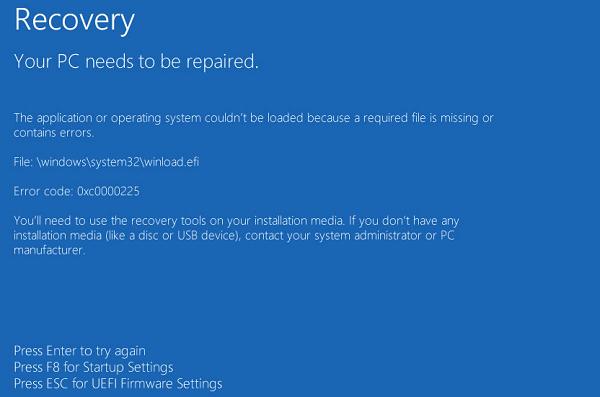
В русской версии Windows ошибка выглядит так:
Ваш компьютер необходимо восстановить
Не удалось загрузить приложение или операционную системы, так как необходимый файл отсутствует или содержит ошибки
Файл \Windows\system32\winload.efi
Код ошибки 0xc0000225
Вам потребуется средства восстановления на установочном носителе. Если установочный носитель (например, диск или USB-устройство) отсутствует, обратиться к администратору или производителю компьютера.
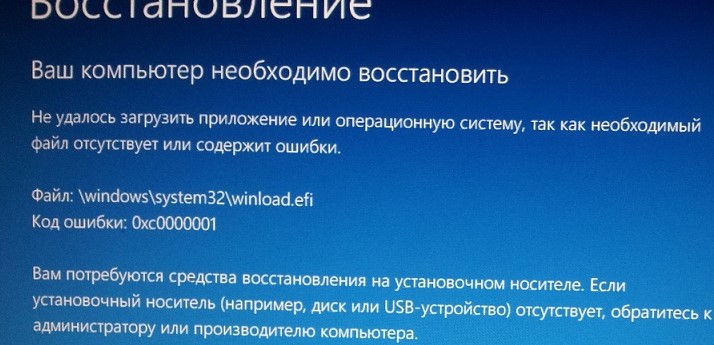
Данная проблема связана с отсутствием или повреждением файла загрузчика \windows\system32\winload.efi. Эта проблема появляется чаще всего после некорректного обновления системы, при повреждении диска или файловой системы, при переразбивке диска сторонними утилитами, обновлении антивируса, после переноса (клонирования) установленного образа Windows на новый диск, замене материнской платы компьютера и прочими вмешательствами.
Файл Winload.efi – это исполняемый файл среды EFI, который инициализирует окружение и запускает загрузку Windows.Если этот файл поврежден, отсутствует или в конфигурации загрузки BCD указан путь к несуществующему тому с файлом winload.efi, Windows не сможет загрузиться.
Решение проблемы зависит от того, использовался ли у вас режим загрузки UEFI или Legacy до возникновения проблемы. Далее рассмотрим основные шаги, которые помогут исправить данную ошибку и корректно загрузить Windows 10/Windows Server 2016.
Содержание:
- Включите режим совместимости CSM и отключите Secure Boot
- Автоматическое восстановление загрузчика Windows
- Отключите функцию защиты ELAM
- Выполните проверку дисков на ошибки и целостность системных файлов
- Восстановление BCD загрузчика и файла winload.efi для UEFI системы
- Пересоздание загрузочных записей в хранилище BCD с помощью bootrec и bcdedit
Включите режим совместимости CSM и отключите Secure Boot
Большинство компьютеров с поддержкой UEFI могут загружаться как с дисков с таблицей разделов GPT, так и с MBR дисков старого формата в режиме совместимости (Legacy).
Перезагрузите компьютер и войдите в меню настройки UEFI. Клавиша входа в меню UEFI зависит от производителя компьютера, как правило, это клавиши F2, F8, Del или Esc. Либо на нажмите кнопку ESC прямо на экране с ошибкой.
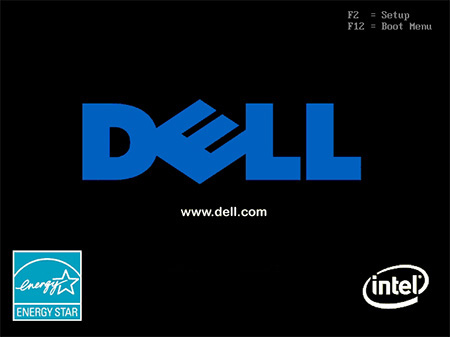
- Попробуйте в настройках UEFI включить режим совместимости CSM Boot (в некоторых версиях прошивок UEFI он может называться Legacy Boot);
- В настройках UEFI найдите и отключите режим Secure Boot. Местоположение данной настройки зависит от производителя прошивки UEFI. Как правило, ее стоит поискать в разделах Security, Authentication или Boot. На ноутбуке HP, например, пункт Secure Boot находится в разделе Security. Измените режим Secure Boot на Disabled или Off;
Совет. Ранее мы уже рассказывали, что такое UEFI и для чего нужен режим Secure Boot. Велика вероятность, что проблема с недоступностью файла winload.efi при загрузке системы исчезнет после отключения режима Secure Boot в настройках UEFI.
- Проверьте приоритет загрузки дисков. Убедитесь, что в качестве первичного устройства загрузки в настройках UEFI выбран ваш жесткий диск с Windows;
- Не забудьте сохранить изменения и перезагрузите устройство;
- Если при загрузке компьютера доступно UEFI Boot меню, попробуйте вручную выбрать запись OS Boot Manager (UEFI) – Windows Boot Manager.
Автоматическое восстановление загрузчика Windows
Попробуйте исправить ошибку с помощью средства автоматического восстановления системы. Для этого:
- Загрузитесь с установочного DVD диска (или загрузочной UEFI флешки) с Windows 10;
- Нажмите кнопку Repair your computer (Восстановить ваш компьютер) или клавишу R;
- Перейдите в раздел Troubleshoot-> Advanced options -> Startup repair (Диагностика -> Дополнительные параметры -> Восстановление системы);
- Запустится мастер восстановления. Далее следуйте его инструкциям.
Если установочного диска с Windows под рукой нет, следует три раза перезагрузить компьютер нажатием на кнопку питания (Power) до тех пор, пока не появится экран консоли восстановления WinRe. Выберите пункт See advanced repair options (Дополнительные варианты восстановления). Далее все аналогично.
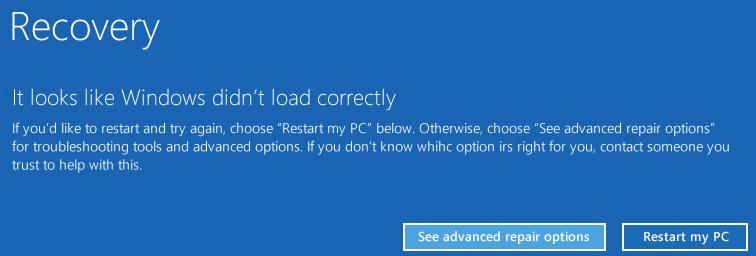
Отключите функцию защиты ELAM
Если предыдущие методы не исправили ошибку с загрузкой winload.efi, попробуйте отключить технологию ранней защиты от вредоносного ПО — ELAM (Early-launch Anti-Malware), которая по умолчанию активна для загрузчика Windows.
Примечание. Технология ELAM – позволяет сертифицированным антивирусам загружаться до запуска всего стороннего ПО. Антивирус в этом случае может выполнять раннюю антивирусную проверку и контролировать запуск драйверов и загружаемого ПО.
Для этого:
- Выполните шаги 1-2 из 2 способа;
- Перейдите в раздел Troubleshoot-> Advanced options -> Startup settings (Диагностика -> Дополнительные параметры -> Восстановление при загрузке);
- Перезагрузите компьютер, нажав кнопку Restart;
- После следующей загрузки, система автоматически откроет меню настройки параметров загрузки — Startup Setting / Параметры загрузки (кстати, именно отсюда можно Windows 10 в безопасном режиме);
- Нажмите F8 чтобы выбрать пункт
Disable early launch anti-malware protection / Отключить автоматическую перезагрузки при сбое системы.
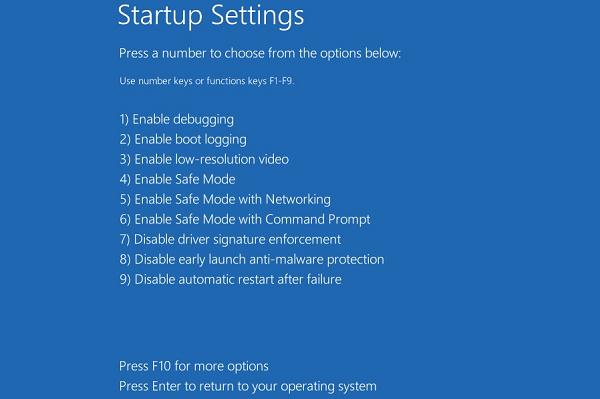
Выполните проверку дисков на ошибки и целостность системных файлов
Проверьте свои диски на наличие ошибок, возможно имеются ошибки диска или файловой системы на разделе с файлом winload.efi. Чтобы проверить все диски на наличие ошибок и исправить их, выполните команду:
chkdsk /f /r
После этого желательно проверить целостность системных файлов с помощью утилиты sfc. Для использования утилиты sfc в офлайн режиме, нужно указать путь к системному диску и папке Windows. Вы можете определить букву диска, назначенную разделу Windows с помощью команды:
Bcdedit /enum | find "osdevice"
Предположим, в вашем случае это диск D:. Команда проверки системных файлов будет выглядеть так:
sfc /scannow /offboot=d:\ /offwindir=d:\windows
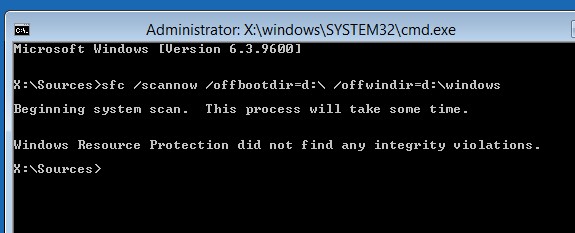
Также нужно выполнить офлайн проверку хранилища компонентов Windows с помощью DISM. Нужно сравнить ваш образ с оригинальным установочным wim файлом вашего билда Windows 10 (предположим, оригинальный wim образ лежите на диске E:):
Dism /image:D:\ /Cleanup-Image /RestoreHealth /Source:E:\sources\install.wim
Совет. Чтобы разобраться с буквами дисков в среде WinPe, выполните команды
Diskpart
List vol
По меткам и размерам диска можно определить букву раздела на диске, на котором у вас хранится установленная Windows.
Восстановление BCD загрузчика и файла winload.efi для UEFI системы
Если ваша Windows 10 была установлена в нативном UEFI режиме на GPT диске, мы рекомендуем вам воспользуетесь инструкцией по пересозданию EFI загрузчика Windows 10 на устройствах с UEFI . Рекомендую воспользоваться статьей по ссылке, там все описано довольно подробно. Здесь оставлю короткий гайд:
Загрузитесь с загрузочного диска и запустите командную строку:
- Выполните команду:
diskpart - Выведите список разделов на дисках:
list volume - айдите раздел с меткой ESP или EFI размером 500 мб (размер и название раздела может отличаться в зависимости от версии Windows, но главное – его файловая система всегда должна быть FAT32). Запомните его номер. Если EFI раздел был случайно удален, его можно восстановить так;
- Выберите этот раздел:
select volume 2 - Назначьте разделу букву диска:
assign letter=Z - Выйдите из diskpart:
exit - Теперь нужно пересоздать загрузчик, скопировать загрузочные файлы из каталога Windows:
bcdboot c:\Windows /s Z: /f ALL
(замените c:\ на букву диска, на котором у вас находится ОС); Если вы все сделали правильно, появится надпись
Boot files successfully created
; - Перезагрузите компьютер и проверьте, исправлена ли проблема.
Пересоздание загрузочных записей в хранилище BCD с помощью bootrec и bcdedit
Если у вас система установлена не в режиме UEFI, тогда вы можете восстановить пересоздать загрузочные записи и сам MBR загрузчик Windows с помощью утилиты bootrec.
- Выполните шаги 1-2 из 2 способа;
- Перейдите в раздел Troubleshoot > Command Prompt (Диагностика – Командная строка).
- В открывшемся окне командной строки выполните последовательно команды:
bootrec /FixMbr
(запись основной загрузочной записи в системный раздел)
bootrec /FixBoot
(перезапись нового загрузочного сектора в системном разделе)
bootrec /ScanOs
(сканирование дисков на предмет наличия установленных ОС)
bootrec /RebuildBcd
(пересоздание конфигурации загрузчика) - Закройте командную строку командой:
exit - Перезагрузите компьютер.
Если предбудущий способ не помог, нужно пересоздать файл конфигурации загрузки для MBR в командной строке консоли восстановления или загрузочного диска:
bcdedit /set {bootmgr} device boot
bcdedit /set {default} device boot
bcdedit /set {default} osdevice boot
bcdedit /set {default} device partition=c:
bcdedit /set {default} osdevice partition=c:
bcdedit /set {default} path \windows\system32\winload.efi
Перезагрузите компьютер и проверьте, исправлена ли проблема.

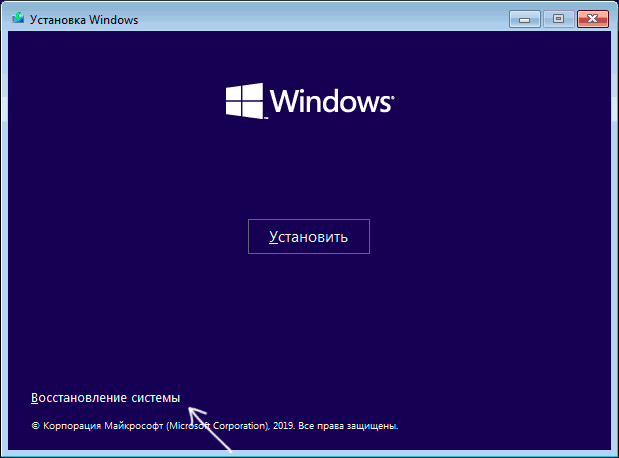
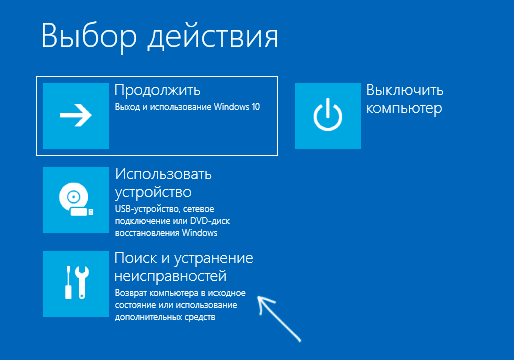
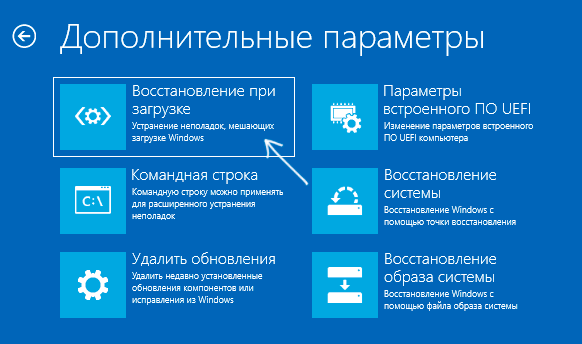



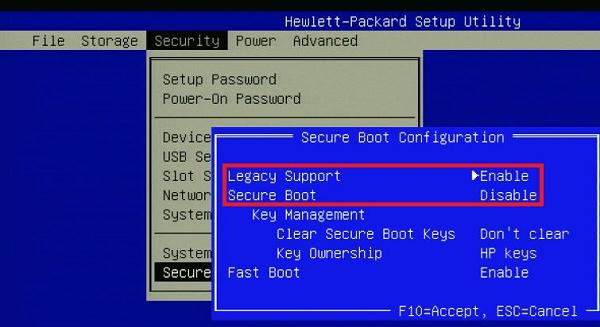
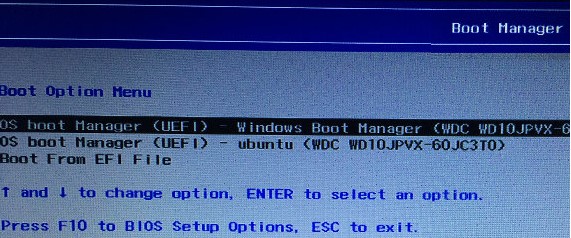
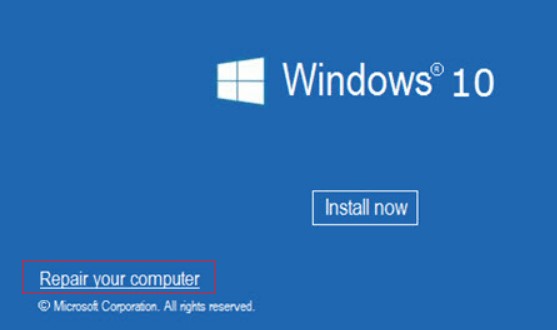
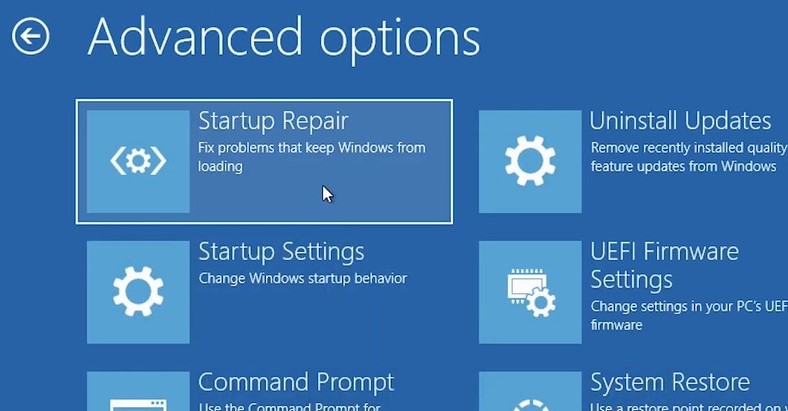
 Disable early launch anti-malware protection / Отключить автоматическую перезагрузки при сбое системы.
Disable early launch anti-malware protection / Отключить автоматическую перезагрузки при сбое системы.